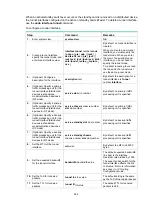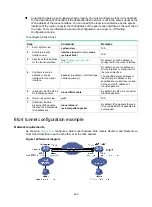
293
When an active/standby switchover occurs or the standby card is removed on a distributed device,
the tunnel interfaces configured on the active or standby card still exist. To delete a tunnel interface,
use the
undo interface tunnel
command.
To configure a tunnel interface:
Step Command
Remarks
1.
Enter system view.
system-view
N/A
2.
Create a tunnel interface,
specify the tunnel mode, and
enter tunnel interface view.
interface tunnel
number
mode
{
advpn
{
gre
|
udp
} [
ipv6
] |
ds-lite-aftr
|
evi
|
gre
[
ipv6
] |
ipv4-ipv4
|
ipv6
|
ipv6-ipv4
[
6to4
|
auto-tunnel
|
isatap
] |
mpls-te
|
nve
}
By default, no tunnel interface is
created.
When you create a new tunnel
interface, you must specify the
tunnel mode. When you enter
the view of an existing tunnel
interface, you do not need to
specify the tunnel mode.
For packet tunneling to succeed,
the two ends of a tunnel must
use the same tunnel mode.
3.
(Optional.) Configure a
description for the interface.
description
text
By default, the description for a
tunnel interface is
Tunnel
number
Interface
.
4.
(Optional.) Specify a primary
traffic processing unit for the
tunnel interface (distributed
devices in standalone
mode/centralized devices in
IRF mode).
service slot
slot-number
By default, no primary traffic
processing unit is specified.
5.
(Optional.) Specify a primary
traffic processing unit for the
tunnel interface (distributed
devices in IRF mode).
service chassis
chassis-number
slot
slot-number
By default, no primary traffic
processing unit is specified.
6.
(Optional.) Specify a backup
traffic processing unit for the
tunnel interface (distributed
devices in standalone
mode/centralized devices in
IRF mode).
service standby slot
slot-number
By default, no backup traffic
processing unit is specified.
7.
(Optional.) Specify a backup
traffic processing unit for the
tunnel interface (distributed
devices in IRF mode).
service standby chassis
chassis-number
slot
slot-number
By default, no backup traffic
processing unit is specified.
8.
Set the MTU of the tunnel
interface.
mtu
size
By default, the MTU is 64000
bytes.
9.
Set the expected bandwidth
for the tunnel interface.
bandwidth
bandwidth-value
The default expected bandwidth
(in kbps) is the interface
maximum rate divided by 1000.
The expected bandwidth for the
tunnel interface affects the link
cost value. For more information,
see
Layer 3—IP Routing
Configuration Guide
.
10.
Set the ToS for tunneled
packets.
tunnel tos
tos-value
The default setting is the same
as the ToS of the original packet.
11.
Set the TTL for tunneled
packets.
tunnel ttl
ttl-value
The default TTL for tunneled
packets is 255.
















































